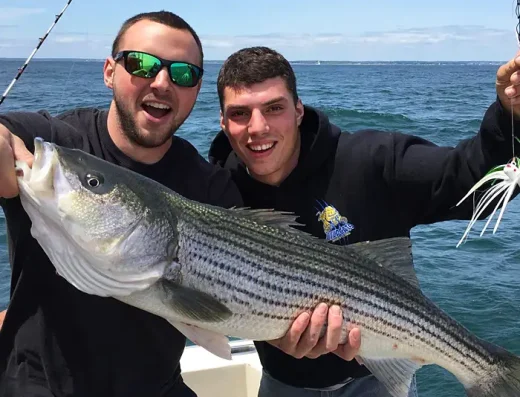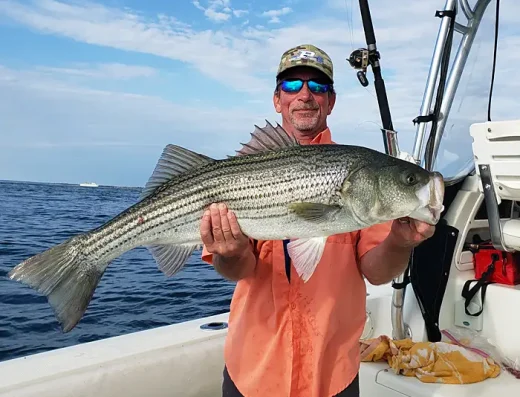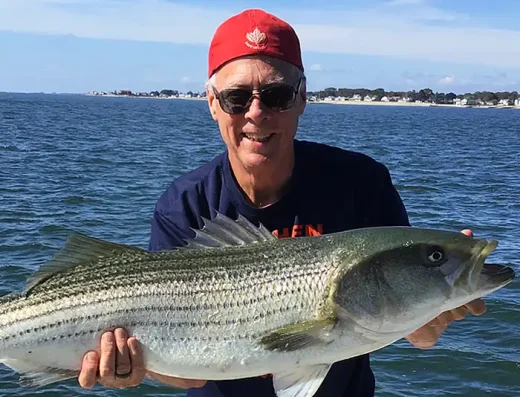Connecticut Fishing Charters
Connecticut fishing charters cover everything from striped bass in Long Island Sound to trout and pike in its rivers, lakes, and reservoirs.
TrustedFish connects anglers with proven local captains in Connecticut —no commissions, no pay-to-play listings, no BS. Every charter on our platform is invite-only, vetted for skill, local knowledge, and reputation. If they’re listed, they’ve earned it.
Top Rated Charters in Connecticut
Click to View destinations
Connecticut Fishing Guide
Connecticut may be small, but the fishery’s no joke. Long Island Sound runs the whole southern edge of the state and stays loaded with stripers, bluefish, and fluke for most of the season. A lot of charters run out of Niantic, New London, and Stamford—most trips stay inside the Sound, but you can run out near Montauk or Plum Gut if you’re chasing the tide lines. Full-day and half-day saltwater trips are both common, depending on target species and time of year. You’ll find bait chunks drifting over reefs, live eels around structure, and diamond jigs under birds in deeper channels.
Head inland and it’s a different world. Candlewood Lake draws bass guys year-round, especially smallmouth hunters. The Connecticut River runs a long way and holds pike, catfish, bass, and even sea-run stripers depending on the section. Up north, the Farmington River’s known for fly fishing, with stocked and wild trout stretches that’ll test your presentation skills. Most freshwater trips are on smaller guide boats or drift setups, launching from public ramps or private docks. You’re usually looking at shorter runs, but the fish can get big, especially in the reservoirs.
Connecticut fishing changes fast with the seasons. Winter shuts a lot down except for hardwater spots and deep holdovers, but spring through fall gives you everything from topwater bass bites to bunker blitzes in the salt. If you’re booking a trip, just make sure you know what you’re chasing—and when. A good local captain will put you where the fish are, but tide, weather, and migration windows matter here.
Regional Fishing Highlights
Long Island Sound (Stamford to Groton)
This stretch covers most saltwater trips in the state. You’ll find charters running for striped bass, bluefish, black sea bass, and fluke. Inshore reefs, rips, and tidal channels are the main battlegrounds. Most skippers run center consoles or small sportfishers and fish with live bunker, squid, or jigs depending on the bite. Stamford, Westport, and Niantic are common jump-off points.
Connecticut River (Old Saybrook to Hartford and beyond)
The river offers big water diversity—down low, you’ll find salt-tolerant stripers and blues; farther up, it’s largemouth, pike, and catfish country. Local guides often target backwater coves or deep holes depending on species. Spring can bring big runs of schoolies. Good shoreline access too if you’re fishing without a boat.
Candlewood Lake
One of the best freshwater lakes in the Northeast for bass. Smallmouth and largemouth both show up strong, especially near rock piles and drop-offs. You’ll see guides using jigs, soft plastics, and topwater early or late in the day. Some trips also target panfish and pickerel. Launches in Danbury and New Milford are common.
Farmington River
The go-to trout water for fly anglers. The upper West Branch has cold, clean flows year-round thanks to bottom-release dams. Guides run float trips or wade sessions, often drifting nymphs and dries through the TMA (Trout Management Area). Fall and spring offer the best action, but summer mornings can still be solid.
Fishing Seasons in Connecticut
Spring
Everything wakes up by April. Saltwater boats chase schoolie stripers moving inshore, while river anglers hit holdover trout and the early pike bite. Candlewood and the river backwaters start heating up for bass. Eels and soft plastics work well in current, especially around the moon tides.
Summer
Saltwater action peaks. Stripers feed on bunker schools, fluke hug the bottom off reefs, and bluefish blitz around mid-Sound. On lakes, bass head deeper but will come up for topwater early and late. Trout fishing slows unless you’re on the Farmington or another cold stream. Best to fish dawn or dusk.
Fall
Striped bass fire back up as they start to migrate south—look for surface feeds and fish busting bait near shore. Bluefish are still around, and blackfish (tautog) season kicks off near reefs and wrecks. Bass and pike action inland ramps up again as temps drop. Fly anglers get another solid trout window.
Winter
Saltwater mostly shuts down, though some holdovers stay in tidal rivers. Inland, it’s ice season. Candlewood and Bantam Lake can produce solid ice fishing for bass, pike, and panfish. Trout stocked in smaller lakes and streams are an option for diehards. Dress warm and know your ice.
Most Popular Gamefish in Connecticut
- Striped Bass – 20–45 inches. Found spring through fall in Long Island Sound and tidal rivers, caught on live bunker, plugs, or eels around structure.
- Bluefish – 5–15 pounds. Summer surface feeds in the Sound; use topwater lures or chunk bait near rips and drop-offs.
- Fluke – 16–26 inches. Fished on the bottom with squid or bucktails near reefs and sandbars June through August.
- Black Sea Bass – 12–20 inches. Targeted over rocky bottoms with baited rigs or jigs, mainly summer and early fall.
- Tautog – 14–22 inches. Found on structure in fall, caught with green crabs or jigs near reefs and wrecks.
- Smallmouth Bass – 1–4 pounds. Found in lakes like Candlewood near rock piles; hit jigs and dropshots spring through fall.
- Northern Pike – 5–15 pounds. Lurks in backwaters of the Connecticut River, hit live shiners or big jerkbaits.
- Rainbow Trout – 10–18 inches. Stocked in rivers and small lakes; caught on spinners, worms, and flies.
- Brown Trout – 12–22 inches. Found in the Farmington and other coldwater rivers; caught on nymphs, streamers, and small plugs.
Connecticut Fishing FAQs
Do I need a fishing license in Connecticut?
Yes. Saltwater and freshwater licenses are required for residents and non-residents. You can get them online or at local tackle shops.
What’s the best time of year to fish in Connecticut?
What’s the best time of year to fish in Connecticut?
Can I keep striped bass I catch in Long Island Sound?
Yes, but size and slot limits apply. As of now, one striper per person between 28–31 inches is the legal slot in most areas.
Are there good places to fish without a boat?
Definitely. The Connecticut River, Farmington River, and various lakes offer solid shore access, especially in state parks and designated walk-in areas.
Where do most saltwater fishing charters leave from?
Popular ports include Stamford, Westbrook, Niantic, and New London. These towns have ramps, marinas, and quick access to inshore structure.
What kind of bait works best for fluke?
Squid strips on a bucktail jig or hi-lo rig. Some anglers tip with spearing or Gulp baits for more scent.
Is the Farmington River open year-round?
Certain stretches are, especially the catch-and-release TMA. It fishes best in spring and fall, but cold flows keep it productive even in summer.
Can kids go on Connecticut fishing charters?
Yes. Most charter captains are used to running family-friendly trips and will tailor the outing to the age and experience of your group.
How long are typical fishing charters in Connecticut?
Half-day trips (4–5 hours) are most common, especially for inshore fishing. Full-day options are available if you’re targeting multiple species or heading farther out.



